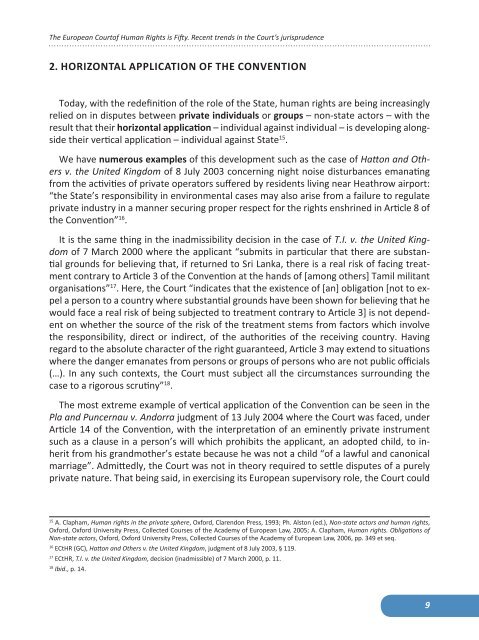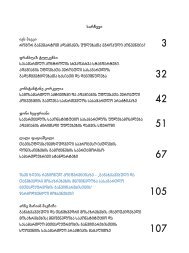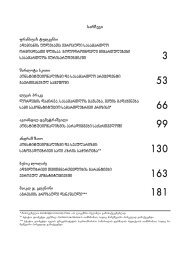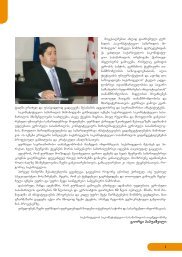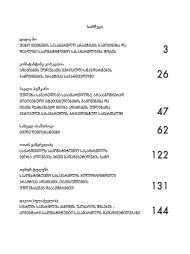Contents - Constitutional Court of Georgia
Contents - Constitutional Court of Georgia
Contents - Constitutional Court of Georgia
Create successful ePaper yourself
Turn your PDF publications into a flip-book with our unique Google optimized e-Paper software.
The European <strong>Court</strong><strong>of</strong> Human Rights is Fifty. Recent trends in the <strong>Court</strong>’s jurisprudence<br />
2. HORIZONTAL APPLICATION OF THE CONVENTION<br />
Today, with the redefinition <strong>of</strong> the role <strong>of</strong> the State, human rights are being increasingly<br />
relied on in disputes between private individuals or groups – non-state actors – with the<br />
result that their horizontal application – individual against individual – is developing alongside<br />
their vertical application – individual against State 15 .<br />
We have numerous examples <strong>of</strong> this development such as the case <strong>of</strong> Hatton and Others<br />
v. the United Kingdom <strong>of</strong> 8 July 2003 concerning night noise disturbances emanating<br />
from the activities <strong>of</strong> private operators suffered by residents living near Heathrow airport:<br />
“the State’s responsibility in environmental cases may also arise from a failure to regulate<br />
private industry in a manner securing proper respect for the rights enshrined in Article 8 <strong>of</strong><br />
the Convention” 16 .<br />
It is the same thing in the inadmissibility decision in the case <strong>of</strong> T.I. v. the United Kingdom<br />
<strong>of</strong> 7 March 2000 where the applicant “submits in particular that there are substantial<br />
grounds for believing that, if returned to Sri Lanka, there is a real risk <strong>of</strong> facing treatment<br />
contrary to Article 3 <strong>of</strong> the Convention at the hands <strong>of</strong> [among others] Tamil militant<br />
organisations” 17 . Here, the <strong>Court</strong> “indicates that the existence <strong>of</strong> [an] obligation [not to expel<br />
a person to a country where substantial grounds have been shown for believing that he<br />
would face a real risk <strong>of</strong> being subjected to treatment contrary to Article 3] is not dependent<br />
on whether the source <strong>of</strong> the risk <strong>of</strong> the treatment stems from factors which involve<br />
the responsibility, direct or indirect, <strong>of</strong> the authorities <strong>of</strong> the receiving country. Having<br />
regard to the absolute character <strong>of</strong> the right guaranteed, Article 3 may extend to situations<br />
where the danger emanates from persons or groups <strong>of</strong> persons who are not public <strong>of</strong>ficials<br />
(…). In any such contexts, the <strong>Court</strong> must subject all the circumstances surrounding the<br />
case to a rigorous scrutiny” 18 .<br />
The most extreme example <strong>of</strong> vertical application <strong>of</strong> the Convention can be seen in the<br />
Pla and Puncernau v. Andorra judgment <strong>of</strong> 13 July 2004 where the <strong>Court</strong> was faced, under<br />
Article 14 <strong>of</strong> the Convention, with the interpretation <strong>of</strong> an eminently private instrument<br />
such as a clause in a person’s will which prohibits the applicant, an adopted child, to inherit<br />
from his grandmother’s estate because he was not a child “<strong>of</strong> a lawful and canonical<br />
marriage”. Admittedly, the <strong>Court</strong> was not in theory required to settle disputes <strong>of</strong> a purely<br />
private nature. That being said, in exercising its European supervisory role, the <strong>Court</strong> could<br />
15 A. Clapham, Human rights in the private sphere, Oxford, Clarendon Press, 1993; Ph. Alston (ed.), Non-state actors and human rights,<br />
Oxford, Oxford University Press, Collected Courses <strong>of</strong> the Academy <strong>of</strong> European Law, 2005; A. Clapham, Human rights. Obligations <strong>of</strong><br />
Non-state actors, Oxford, Oxford University Press, Collected Courses <strong>of</strong> the Academy <strong>of</strong> European Law, 2006, pp. 349 et seq.<br />
16 ECtHR (GC), Hatton and Others v. the United Kingdom, judgment <strong>of</strong> 8 July 2003, § 119.<br />
17 ECtHR, T.I. v. the United Kingdom, decision (inadmissible) <strong>of</strong> 7 March 2000, p. 11.<br />
18 Ibid., p. 14.<br />
9


